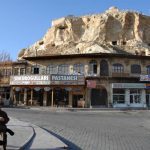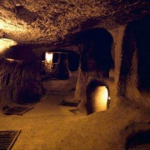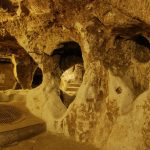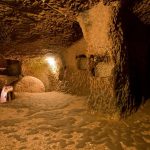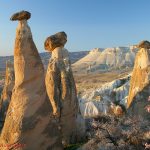It is 13 km away from Nevşehir and 2 km from Goreme Town. A rock settlement on the east side. M.S. A monastery lived from the 4th century to the 13th century. Almost every rock block in the district has churches, chapels, dining halls and living areas.
Today, the area called Göreme Open Air Museum is the position where this education system is started. The churches in the district are painted with two different techniques. The first is direct dyeing on the rock surface and the second is the dyeing with secco and fresco technique on the rock. The subjects in the church are predominantly from the Bible and Hz. It presents sections from the life of Jesus.
There are many churches in Goreme Open Air Museum.
Convent of Priests and Sisters: The rock mass that forms 6-7 cats on the left side of the entrance to the museum is known as the “Monastery of the Sisters”. The dining room on the first floor of this monastery, the kitchen and several rooms, and the ruined chapel on the second floor can also be visited today. The church on the 3rd floor is cross-domed and consists of four columns and three apstists. The main apsist templona can not be seen in other churches in Goreme.
In addition to the Jesus fresco which was made directly on the rock in the Monastery of Priests and Sisters, red beads can still be seen. The connection between the floors in the monastery is provided by the tunnel. “Sliding stones” were used as in the underground cities to shut down tunnels in the event of danger from outside. On the right is the Convent of the Priests, because of erosion, the passage between the floors is closed, so only a few rooms on the ground floor are accessible.
Aziz Basil Chapel: At the entrance of the museum, there are nartekste grave pits separated by columns in the chapel. St. Basil Chapel is thought to have been built in the 11th century. If we talk about the scenes in the chapel; The main apsiste is the portraits of Jesus, depicted on the front of the Virgin Mary and child Jesus, the St. George on the horse on the north side, and St. George on the south side again fighting the dragon on the horse, St. Demetrius and 2 apostles.
Elmalı Church: The Elmalı Church consists of nine domes, four columns and three apstists. Although the entrance point is from the south direction, entrance to the church is possible thanks to the tunnel opened from the north. The ornaments of the church are made up of crosses and geometric motifs made with red paint directly on the wall. It is estimated that the history of the church construction dates from the end of the 11th century to the beginning of the 12th century.
If we talk about the scenes in the Elmalı Church, Deesis, birth, worship of three astrologers, baptism, Lazarus’s resurrection, metamorphosis, entrance to Jerusalem, last evening’s dinner, betrayal, Jesus on the road to Golgota, Jesus on the cross, Jesus ‘burying, Jesus’ hellish descent , The exodus of Jesus and the depictions of saints. Apart from these depictions, there are also depictions of the hospitality of the Prophet Abraham and the burning of three Jewish generals.
Azize Barbara Chapel: The motifs in Azize Barbara Chapel, which is located at the back of the rock block where the Elmalı Church is located, is painted directly on the rock with red paint. There are various geometric motifs, mythological animals and military symbols on both the walls and the dome. There are also motifs on the walls that give a stone appearance. It is estimated that the date on which the building was built corresponds to the second half of the 11th century.
If we were going to talk about the scenes in Azize Barbara Chapel; The main apsiste is the pantheist Jesus, the saint George and St. Theodore fighting the dragon on the horse on the northern cross, and the Aziz Barbara on the western cross.
Yılanlı (St. Onuphrius) Church: The entrance to the church is from the north, and on both sides of the church vault are depictions of the esteemed saints of Cappadocia. It is estimated that the date on which the church was built corresponds to the 11th century.
If we were going to talk about the scenes in Yılanlı Church; Jesus holding the Bible in his left hand and the banister of the church right next to him, St. Onesimus, St. George and the St. Theodore fighting the dragon, Helena holding the true cross and his son Constantine; On the western side of the vault is St. Onuphrius, a naked, long haired palm tree in front of him, St. Thomas standing in a position of favor and Saint Basil with a book in his hand.
Pantry / Kitchen / Cafeteria: All three buildings are side by side and connected with each other. In the pantry section there are cavities to store supplies. In the kitchen section there is a hearth called “tandır” which is made from the soil still used in the local villages. In the last section, the dining room, there are tables and tables for 40 – 50 people to eat at the same time. On the right side of the table, there is also a shisha to crush grapes.
















